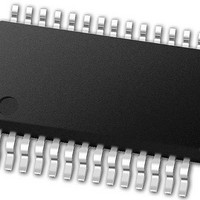PIC24FJ64GB002-I/SS Microchip Technology, PIC24FJ64GB002-I/SS Datasheet - Page 106

PIC24FJ64GB002-I/SS
Manufacturer Part Number
PIC24FJ64GB002-I/SS
Description
16-bit, 16 MIPS, 64KB Flash, 8KB RAM, Nanowatt XLP, USB OTG 28 SSOP .209in TUBE
Manufacturer
Microchip Technology
Specifications of PIC24FJ64GB002-I/SS
Processor Series
PIC24
Core
PIC24F
Data Bus Width
16 bit
Program Memory Type
Flash
Program Memory Size
64 KB
Data Ram Size
8192 B
Interface Type
I2C, SPI, UART
Maximum Clock Frequency
32 MHz
Number Of Programmable I/os
21
Number Of Timers
5
Operating Supply Voltage
2 V to 3.6 V
Maximum Operating Temperature
+ 85 C
Mounting Style
SMD/SMT
Package / Case
SSOP-28
Development Tools By Supplier
MPLAB Integrated Development Environment
Minimum Operating Temperature
- 40 C
Operating Temperature Range
- 40 C to + 85 C
Supply Current (max)
300 mA
Lead Free Status / Rohs Status
Lead free / RoHS Compliant
Available stocks
Company
Part Number
Manufacturer
Quantity
Price
Part Number:
PIC24FJ64GB002-I/SS
Manufacturer:
MICROCHIP/微芯
Quantity:
20 000
- Current page: 106 of 352
- Download datasheet (3Mb)
PIC24FJ64GB004 FAMILY
7.4
7.4.1
To configure an interrupt source:
1.
2.
3.
4.
7.4.2
The method that is used to declare an ISR and initialize
the IVT with the correct vector address will depend on
the programming language (i.e., ‘C’ or assembler) and
the language development toolsuite that is used to
develop the application. In general, the user must clear
the interrupt flag in the appropriate IFSx register for the
source of the interrupt that the ISR handles. Otherwise,
the ISR will be re-entered immediately after exiting the
routine. If the ISR is coded in assembly language, it
must be terminated using a RETFIE instruction to
unstack the saved PC value, SRL value and old CPU
priority level.
DS39940D-page 106
Note:
Set the NSTDIS control bit (INTCON1<15>) if
nested interrupts are not desired.
Select the user-assigned priority level for the
interrupt source by writing the control bits in the
appropriate IPCx register. The priority level will
depend on the specific application and type of
interrupt source. If multiple priority levels are not
desired, the IPCx register control bits for all
enabled interrupt sources may be programmed
to the same non-zero value.
Clear the interrupt flag status bit associated with
the peripheral in the associated IFSx register.
Enable the interrupt source by setting the
interrupt enable control bit associated with the
source in the appropriate IECx register.
Interrupt Setup Procedures
INITIALIZATION
INTERRUPT SERVICE ROUTINE
At a device Reset, the IPCx registers are
initialized, such that all user interrupt
sources are assigned to Priority Level 4.
7.4.3
A Trap Service Routine (TSR) is coded like an ISR,
except that the appropriate trap status flag in the
INTCON1 register must be cleared to avoid re-entry
into the TSR.
7.4.4
All user interrupts can be disabled using the following
procedure:
1.
2.
To enable user interrupts, the POP instruction may be
used to restore the previous SR value.
Note that only user interrupts with a priority level of 7 or
less can be disabled. Trap sources (Level 8-15) cannot
be disabled.
The DISI instruction provides a convenient way to
disable interrupts of Priority Levels 1-6 for a fixed
period of time. Level 7 interrupt sources are not
disabled by the DISI instruction.
Push the current SR value onto the software
stack using the PUSH instruction.
Force the CPU to Priority Level 7 by inclusive
ORing the value OEh with SRL.
TRAP SERVICE ROUTINE
INTERRUPT DISABLE
2010 Microchip Technology Inc.
Related parts for PIC24FJ64GB002-I/SS
Image
Part Number
Description
Manufacturer
Datasheet
Request
R

Part Number:
Description:
Manufacturer:
Microchip Technology Inc.
Datasheet:

Part Number:
Description:
Manufacturer:
Microchip Technology Inc.
Datasheet:

Part Number:
Description:
Manufacturer:
Microchip Technology Inc.
Datasheet:

Part Number:
Description:
Manufacturer:
Microchip Technology Inc.
Datasheet:

Part Number:
Description:
Manufacturer:
Microchip Technology Inc.
Datasheet:

Part Number:
Description:
Manufacturer:
Microchip Technology Inc.
Datasheet:

Part Number:
Description:
Manufacturer:
Microchip Technology Inc.
Datasheet:

Part Number:
Description:
Manufacturer:
Microchip Technology Inc.
Datasheet:











